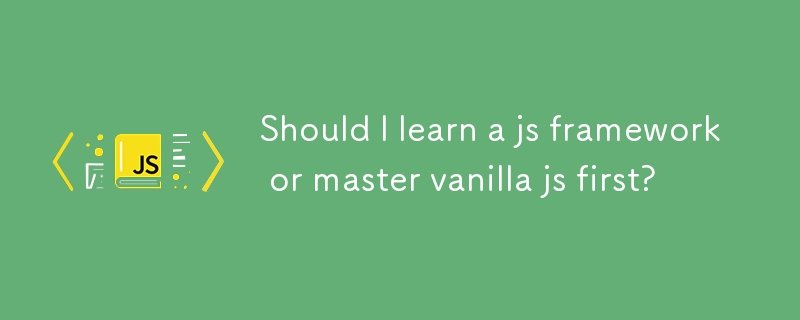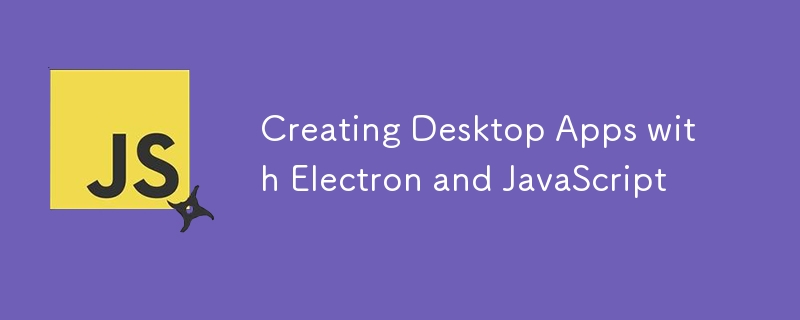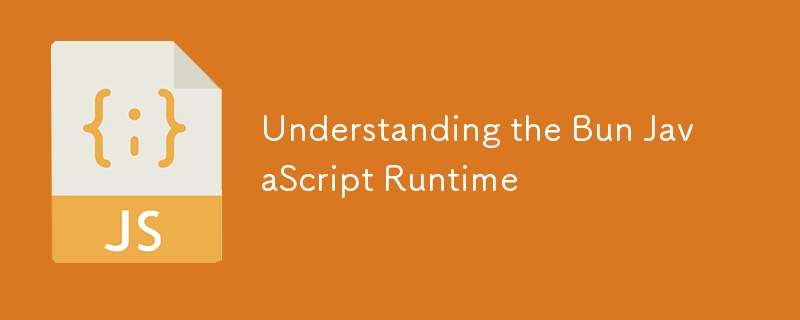Found a total of 10000 related content

Should I learn a js framework or master vanilla js first?
Article Introduction:The answer is: you should first master native JavaScript and then learn the framework. Because frameworks are just tools, JS is the foundation, not understanding JS will make it difficult to troubleshoot bugs and deal with interview questions; understanding native JS can help you better understand the design ideas of the framework; learning to be able to operate DOM, handle events, use Promise, understand this and prototype chains, and write simple interaction functions can start learning the framework; it is recommended to start with HTML CSS native JS first, learn while doing, read more documents, read less quick courses, and write projects by hand.
2025-07-01
comment 0
574

The Future of Web Animation: WAAPI vs. CSS vs. JS
Article Introduction:CSS animation is most suitable for simple and high-performance UI effects, such as transition and hover animation, because of hardware acceleration and no JS is required; 2. WAAPI is suitable for sequence animations that require program control, and provides functions such as pause and reversal, with performance close to CSS and native support; 3. JS animation library (such as GSAP) is suitable for complex scenes such as scroll triggering or SVG deformation, with strong control power but increases the volume of the package and may block the main thread.
2025-07-29
comment 0
657

HTML `datalist` for Autocomplete Suggestions
Article Introduction:How to use HTML native tags to achieve automatic completion of input boxes? 1. Use and association, bind id through list attributes; 2. Add multiple options to datalist as suggestions; 3. Options can be generated dynamically through JavaScript to achieve dynamic loading; 4. Pay attention to the compatibility and style limitations of different browsers, and use JS to implement them yourself when interaction requirements are high.
2025-07-23
comment 0
395

What is the difference between Shadow DOM and Virtual DOM
Article Introduction:ShadowDOM is a browser-native component encapsulation mechanism used to isolate structures and styles; VirtualDOM is a programming technique that optimizes UI updates. 1. ShadowDOM belongs to WebComponents, creates independent and isolated DOM trees to prevent style pollution, and is suitable for building reusable components such as or. 2. VirtualDOM is implemented by frameworks such as React, which simulates real DOM in memory, minimizes update operations through the Diff algorithm, and improves performance. 3. The core difference between the two is their different functions: ShadowDOM focuses on packaging, while VirtualDOM focuses on efficient updates; different implementation methods: the former is native browser support, while the latter is JS simulation; application field
2025-07-07
comment 0
417

Understanding Frontend Build Tools: Webpack vs Rollup vs Vite
Article Introduction:Webpack is suitable for large applications, with comprehensive functions but complex configuration; Rollup focuses on packaging libraries, with small output size and strong Tree-shaking; Vite is based on native ES modules, with fast development speed and suitable for modern frameworks. 1. Webpack is centered on "Everything is a module" and supports code segmentation and rich plug-ins. It is suitable for complex projects but slow to build; 2. Rollup supports ESM by default, outputs clean code, suitable for NPM library release, but weakly handles non-JS resources; 3. Vite uses browser native ESM, does not package in the development stage, starts quickly and supports mainstream frameworks, suitable for new projects, but TS and migration support needs to be improved.
2025-07-17
comment 0
172

Implementing HTML `ping` Attribute for Link Tracking
Article Introduction:The ping attribute is a native method in HTML for tracking link clicks. It sets the ping attribute value to one or more URLs in the or tag. When the user clicks on the link, the browser will send a POST request to these URLs for recording. When using it, you need to ensure that the pingURL is accessible and responds quickly, support multi-address space separation, verify server reception, and pay attention to privacy and compliance issues; it is suitable for external link statistics, no JS tracking and A/B testing scenarios, but there are restrictions such as browser compatibility, plug-in interception and error-free processing. It is recommended to combine JS events to improve reliability.
2025-07-28
comment 0
520

HTML `template` Element for Reusable Content
Article Introduction:It is a native element in HTML that defines a reusable structure. The content is not displayed by default. The DOM needs to be inserted through JavaScript. Its core uses include: 1. Store reusable HTML fragments; 2. Support browser parsing internal structures, which are different from script tags; 3. Applicable to dynamically generate lists, component development, and reduce network requests; 4. Can be used to build encapsulated components with ShadowDOM; 5. Multi-page reuse can be introduced through iframe, JS or build tools.
2025-08-02
comment 0
150

H5 WebAssembly for Image and Video Processing
Article Introduction:WebAssembly (Wasm) is a binary instruction format suitable for image and video processing due to its near-native execution speed. 1. It supports compiling into intermediate formats in multiple languages, and runs efficiently in the browser; 2. Image and video processing involves a large amount of calculations, and Wasm is more efficient than JavaScript; 3. Select language and tool chain when using it, encapsulate functions to receive image data, and JS passes data to Wasm for processing and then passes the results back; 4. Video processing requires controlling frame rate, synchronization and memory management, JS grabs frames and passes them to Wasm for processing and then synthesis; 5. Pay attention to data format conversion, memory allocation and release, performance bottleneck positioning, and browser compatibility issues.
2025-07-17
comment 0
991

How to handle cookies in vanilla JavaScript?
Article Introduction:1. When reading cookies, you can get a string through document.cookie and parse it into an object; 2. When setting cookies, you need to assign a value to document.cookie and add expiration time, path and other options; 3. When deleting cookies, you need to set the expired time and ensure clearing through the same path domain name; 4. Notes include not having sensitive information, processing encoding, limiting length and adding security attributes. The full text revolves around the methods and details of native JS operating cookies.
2025-07-15
comment 0
657

Essential React Native Performance Tips and Tricks
Article Introduction:A practical guide to improving the performance of React Native applications
Key Points
Balancing the animation processing of JavaScript (JS) threads and main threads to improve application performance. Use the useNativeDriver attribute and InteractionManager to manage this balance.
Avoid unnecessary component re-rendering. Tips include: memorizing components and functions, using useCallback wisely, avoiding updating local states with Redux states, and avoiding inline functions.
Optimize images to increase application speed. Use SVG icons and images, WebP image format (lossless image quality), and cache images to speed up rendering.
Using stable npm packages and Fla
2025-02-08
comment 0
408

Simple State Management in JavaScript with Nanny State
Article Introduction:Nanny State: A streamlined Vanilla JS state management library
Nanny State is a mini library designed to simplify the process of building state-based web applications using native JavaScript. It's similar to React, but with less overhead, no need to learn new syntax. It uses a single application-wide state object instead of letting each component have its own state. It was inspired by HyperApp and has many similarities with Elm.
This article will explain how Nanny State works and demonstrate its functionality with several examples.
Key points:
Nanny State Introduction: Nanny S
2025-02-09
comment 0
336

Creating Desktop Apps with Electron and JavaScript
Article Introduction:Use Electron and JavaScript to build cross-platform desktop applications based on HTML, CSS, and JS; 2. You need to distinguish between the main process (manage windows and life cycles) and the rendering process (processing UI and communicating through IPC); 3. Use electron-builder to package and generate installation files for each platform; 4. Optimize performance, ensure secure configuration, and use native modules to improve the experience - mastering Web skills can develop complete desktop applications, which are still suitable for most cross-platform scenarios despite the size and memory overhead.
2025-07-30
comment 0
116

What is a js library and which one should I learn?
Article Introduction:JavaScript library is a pre-written collection of code used to help developers complete common tasks efficiently. Its core functions include: 1. Simplify DOM operations; 2. Handle user interaction; 3. Send HTTP requests. Popular JS libraries include: 1.jQuery is suitable for small projects or legacy systems; 2.React is suitable for building dynamic user interfaces; 3.Vue.js is suitable for progressive integration; 4.Axios simplifies API calls. Learning suggestions: 1. If you want to master the basics, you must first learn native JS; 2. jQuery is available for small websites; 3. React is the first choice for modern front-end development; 4. Axios can be selected only if you need API calls. It is recommended that most developers give priority to learning React, but the premise is to master variables and cycle
2025-06-27
comment 0
218

Frontend Development with WebAssembly for CPU-Intensive Tasks
Article Introduction:WebAssembly (WASM) is a binary format that runs in a browser, suitable for CPU-intensive tasks. The reasons include: 1. Fast execution speed and close to native code; 2. Supports multiple system-level languages such as Rust and C; 3. Runs in a secure sandbox; 4. Cross-platform compatibility. The key steps to integrate WASM into front-end projects are: 1. Select toolchains such as Rust and wasm-pack; 2. Write and export Rust functions; 3. Compile into .wasm files; 4. Load and call them on the front-end. Applicable scenarios include pure computing tasks such as image processing, encryption, data compression, etc., and the performance can be 5 to 10 times higher than JS. However, tasks such as DOM operations that rely on browser APIs should still use JS
2025-07-19
comment 0
454

Utilizing New HTML5 Input Types for Enhanced Forms
Article Introduction:The new HTML5 input type improves the form experience, the main methods include: 1. Use email and url types to realize automatic format verification and optimize the mobile keyboard; 2. Use number and range to process numerical input, which are suitable for accurate values ??and sliding selection respectively; 3. Use date series types to call the native date selector to improve time input efficiency. These features reduce the burden of front-end verification, but basic verification still needs to be supplemented by the server. Some types need to be combined with JS libraries to ensure compatibility on old devices.
2025-07-11
comment 0
388

Creating Interactive HTML Prototypes
Article Introduction:The key to making interactive HTML prototypes is to master the coordination of structure, style and behavior. 1. Use basic HTML to build structures, such as buttons and pop-up elements; 2. Use CSS to control state changes, replace frequent DOM operations through class switching, improve debugging efficiency; 3. Use native JS to achieve simple interaction, such as clicking to show or hide elements, keep the code lightweight; 4. Add animation effects to improve the experience, such as pop-ups fade in and out, but avoid excessive complexity. Through these steps, you can quickly verify ideas and demonstrate a clear process.
2025-07-26
comment 0
684

Generating and managing Assets using Laravel Mix or Vite.
Article Introduction:LaravelMix and Vite are both used for front-end resource management, but each has its own characteristics. 1.LaravelMix is based on Webpack and is suitable for small and medium-sized projects, with simple and intuitive configuration; 2. Vite starts faster and supports instant hot updates, which is more suitable for large projects; 3. Both support the processing and version control of resources such as CSS, JS and pictures, but Vite uses native ES modules in development mode, without packaging steps; 4. During deployment, Mix needs to manually enable version control, while Vite automatically generates hash file names to ensure cache updates.
2025-08-04
comment 0
677

Designing and Building H5 Micro-Frontends
Article Introduction:Why choose H5 micro front-end? Because it can split large applications into small independent modules, improve development efficiency and reduce maintenance costs, it is suitable for projects with frequent team collaboration and fast changes in demand. Advantages include flexibility in the technology stack (supports React, Vue, native JS), support for rapid iteration (local updates do not affect the overall situation), and team decoupling (clearer internal work between the front and back ends and the front end). 1. The main sub-application loading mechanism is recommended to use a JS runtime loading scheme similar to qiankun, which supports life cycle management; 2. The route management is recommended to use sub-application self-management routing to maintain integrity and facilitate migration; 3. The communication mechanism can be encapsulated through a unified interface, using event bus or shared state objects, avoiding direct operation of windows. Other things to note
2025-07-19
comment 0
436

Understanding the Bun JavaScript Runtime
Article Introduction:Bun is a modern JavaScript/TypeScript runtime designed to provide faster performance and built-in toolset than Node.js. 1. It uses the JavaScriptCore engine, which starts faster and has lower memory footprint; 2. It has built-in packager, test framework and dependency manager, without additional installation tools; 3. It is compatible with some Node.js API, suitable for fast script development, small services and simplified building toolchain; 4. It is simple to install and use, and supports running JS/TS/JSX files and dependency installation; 5. It is currently suitable for projects that do not rely on complex Node.js native modules, and is not yet suitable for large production environments.
2025-07-16
comment 0
494



















